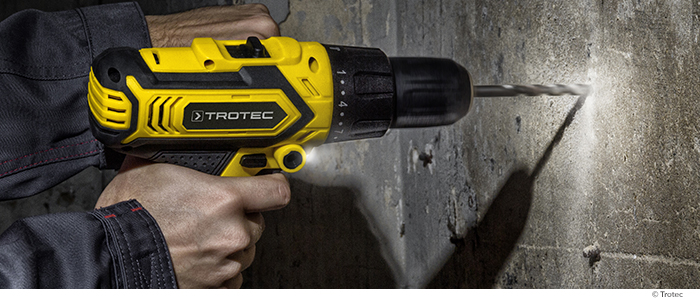You should take a closer look at our manual with tips for correctly drilling; because nobody comes into this world with a licence to professionally drill holes into walls and yet it forms a common part of DIY work. Learn how to remain safe during drilling work, which drill bits and power drill you should use, how you can avoid crooked drill holes, and how to effortlessly stay safe from airborne dust and dirt.
Drill safely – with suitable protective clothing and a locating device
Appropriate protective clothing is often done without during DIY. But because dust and dirt can get into your eyes, protective goggles are absolutely essential at the very least! Tight-fitting gloves also provide additional safety, and ear protection is sensible during longer work with percussion and hammer drills.
Very important: It is imperative that the wall is scanned for electric cables and water pipes using a locating device, for example the BI15 Wallscanner from Trotec, before any drilling takes place, so as to not accidentally damage them. The BI15 is affordable and preserves both your drill and nerves in equal measure by enabling the detection of live cables, metal pipes and wooden substructures in walls and floors with extreme ease.
Perfect drilling I – with the suitable wooden, stone or metal drill bits
Wooden drill bits have a central point with two taper taps. Metal drill bits have no central point as these would quickly break off against hard materials. Stone drill bits have carbide inserts fitted onto their tips. That means that the right drill bits must be selected depending on the material. If you do not have the basic set of wooden, stone and metal drill bits yet or if you require spares, then choose the 15-piece stone, wood or HSS metal drill bit sets with Trotec brand quality – professionally manufactured with a straight shank, they can be combined with all common rotary and percussion drills.
Perfect drilling II – with the most practical power drill
The following phrase is applicable as a general rule: The more powerful the motor, the wider the range of applications. A battery-powered drill is the tool of choice for simpler jobs such as drilling into drywall and porous concrete. For classical masonry, it is best to proceed with a high-performance percussion power drill. And concrete walls should be handled using a hammer drill. Important for any drilling into porous material: The percussion function must be deactivated so that the hole does not crack.
When choosing the right drilling tool, it’s definitely worth taking a look at Trotec’s online tool site. From high-performance cordless drills and cordless percussion drills to hammer drills: be clever about it and pick the power tools from Trotec – a good price, product and design all rolled into one.
Drill straight – avoid crooked holes
Set the drill bit point perpendicular to the material surface and start the machine without applying pressure and with a low revolution speed. This way you prevent any slips and avoid any crooked holes from the get-go. When the drill has found a secure hold, slowly and gradually increase the pressure on the machine.
Drilling into tiles – without large or small cracks
If possible, drilling through tiles should be avoided and the drill holes should be set into the grooves instead. This is because most tiles have a very smooth surface and the drill can easily jump when you want to drill through them. If tiles must be drilled through, however, then stick a piece of masking tape over the position of the hole: The rough surface will prevent the drill from slipping and damaging the surface beneath. To avoid cracks in the tile, you should also work using a very low rotary speed and minimal pressure.
Clean drilling – prevent dirt and dust
Nothing is more irritating than wiping up drill dust that, like mildew, covers everything (even the small areas) after doing the job. So that it can’t spread around the room in the first place, ideally a second person should hold a vacuum cleaner hose directly under the drill hole. If you are working alone, you could stick a small paper envelope or coffee filter directly underneath the drill hole to collect the drill dust. And for drilling in the ceiling, a yoghurt pot is helpful: Cut off the upper half and drill a hole into the pot’s base. Now, with the yoghurt pot on the drill, a hole can be put into the ceiling and the drill dust can cleanly flow into the cup instead of into your eyes!
Precession measuring devices, power tools and tool accessories – from Trotec!
As a DIY enthusiast, you should not pass up on this opportunity: Take a look at our comprehensive range of precision measuring devices, our tool accessories and our invariably extensive range of electric power tools – Trotec power tools: All professional Trotec solutions with an exceptional price-performance ratio – now in the Trotec shop!


